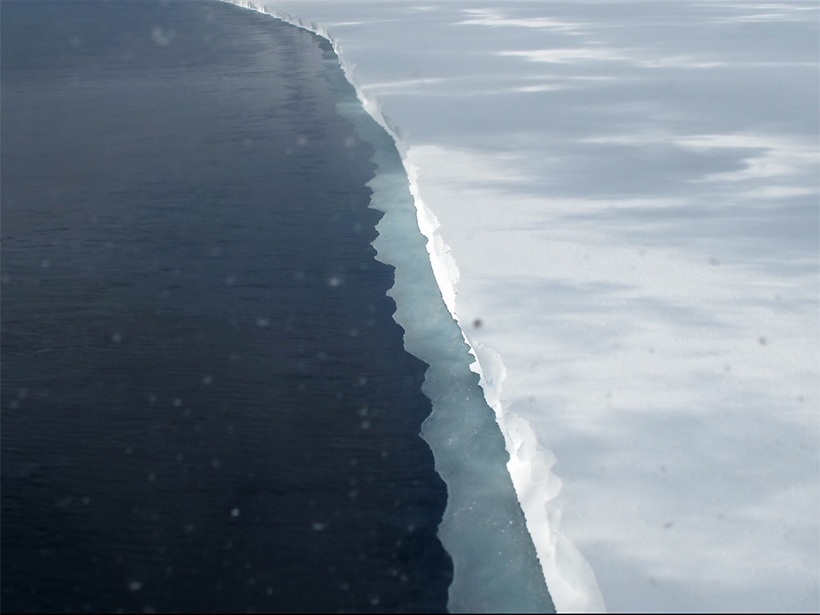The Ross Ice Shelf, a floating expanse of ice with roughly the area of California, is a critical component of Antarctica’s frozen landscape, acting as a buttress that prevents glacial ice from flowing unimpeded into the sea.
Now, researchers have shown how the underside of the Ross Ice Shelf is being eroded by solar-heated water that plunges under the ice shelf during the austral summer. Although the Ross Ice Shelf is currently stable—snowfall replaces the ice lost by this basal melting—melt rates will likely increase as temperatures increase worldwide, the scientists suggest in a paper published last week in Nature Geoscience.
Ground Truthing
“If we lost the Ross Ice Shelf…that would eventually result in several meters of sea level rise.”
“If we lost the Ross Ice Shelf…that would eventually result in several meters of sea level rise,” said Craig Stewart, a marine physicist at the National Institute of Water and Atmospheric Research in Wellington, New Zealand.
Between 2011 and 2014, Stewart and his colleagues traveled to Antarctica four times. They went to ground truth satellite observations, which have suggested that the underside of the Ross Ice Shelf is losing, on average, about 10 centimeters of ice per year.
Stewart and his collaborators collected data from 78 locations around the northwestern part of the Ross Ice Shelf. They used a radio-echo sounder, a basketball-sized instrument nestled in a bright yellow plastic case, to launch radio waves into the ice.
By recording the echo of the waves as they bounced off the bottom of the Ross Ice Shelf, the team estimated the precise thickness of the shelf. “The frequency of the signal that returns to you is proportional to the two-way travel time,” said Stewart, who was at the University of Cambridge in the United Kingdom when most of this research was done.
Stewart and his colleagues repeated these measurements over different time periods to estimate daily and yearly melt rates.
Unexpected Melt Rates
During the austral summer in January 2013, the scientists calculated that one part of the shelf thinned by over 0.7 meter in less than a week.
“We were amazed to see some of the melt rates,” said Stewart.
Across the roughly 8,000 square kilometers of the Ross Ice Shelf they instrumented, the researchers found that the ice thinned by, on average, 1.3 meters per year. “That’s about an order of magnitude higher than the estimates across the entire ice shelf,” said Stewart.
This rapid melting was likely caused by warmer water percolating around the underside of the Ross Ice Shelf, Stewart and his colleagues knew. But where did this water come from, and what heated it? The answers lay just beyond the ice, the researchers soon realized.
“Melt rates were linked to the change in temperature, and we could see where the water was coming from based on temperature and salinity characteristics.”
Off the northwestern coast of the Ross Ice Shelf, strong winds blow sea ice away and create an expanse of exposed water, a feature known as a polynya. Because water is more efficient at absorbing sunlight than ice, water in the Ross Sea Polynya heats up. (But not by much: Its temperature peaks at around +1°C.)
Stewart and his collaborators studied this water using a conductivity, temperature, depth (CTD) sensor cast roughly 110 kilometers from the edge of the Ross Ice Shelf. They compared these measurements with data they collected from a mooring installed underneath the Ross Ice Shelf. The scientists found remarkably good agreement: The temperature and salinity of the solar-heated water matched those of the water near the underside of the Ross Ice Shelf during periods of peak melting.
“It all started to make sense,” said Stewart. “Melt rates were linked to the change in temperature, and we could see where the water was coming from based on temperature and salinity characteristics.”
A Watery Mystery
One enduring mystery was how this surface water, which is relatively buoyant, sunk around the Ross Ice Shelf.
“It hasn’t just flooded in horizontally,” said Stewart. “It’s actually downwelled into the cavity quite considerably.”
Using modeling done by other groups, the researchers concluded that gradients in water density were likely responsible. Ice crystals tend to reject salt as they form, resulting in the expulsion of briny water into the sea. This salty, dense water then sinks, setting up currents and eddies that can entrain surface water, the researchers concluded.
Given the warming temperatures around Antarctica, it’s quite likely that there will be less sea ice in the future, said Stewart. That’ll mean more open water in the Ross Sea Polynya that can be heated by the Sun. “You’ve got a potential for increasing melt rates.”
“Field observations of this kind are scarce and extremely valuable,” said Fernando Paolo, a polar scientist at NASA’s Jet Propulsion Laboratory in Pasadena, Calif., not involved in the research. “The study reaffirms the importance of looking at polynyas to better understand mass exchanges between the ice shelves and the ocean.”
—Katherine Kornei (@katherinekornei), Freelance Science Journalist
Citation:
Kornei, K. (2019), Warm water is rapidly eroding Antarctica’s Ross Ice Shelf, Eos, 100, https://doi.org/10.1029/2019EO123031. Published on 07 May 2019.
Text © 2019. The authors. CC BY-NC-ND 3.0
Except where otherwise noted, images are subject to copyright. Any reuse without express permission from the copyright owner is prohibited.

